Ang Li
Iterative Geometry-Aware Cross Guidance Network for Stereo Image Inpainting
May 11, 2022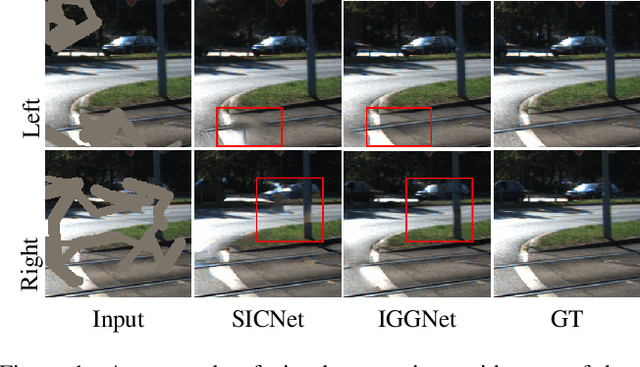
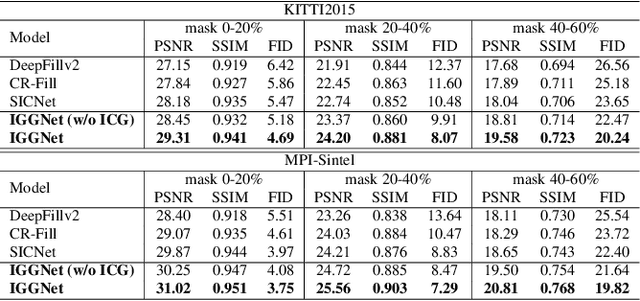
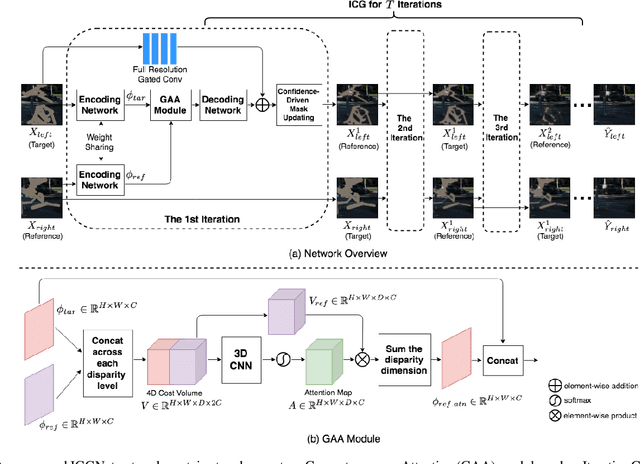
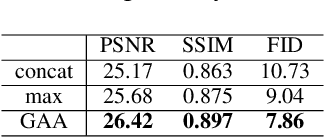
Abstract:Currently, single image inpainting has achieved promising results based on deep convolutional neural networks. However, inpainting on stereo images with missing regions has not been explored thoroughly, which is also a significant but different problem. One crucial requirement for stereo image inpainting is stereo consistency. To achieve it, we propose an Iterative Geometry-Aware Cross Guidance Network (IGGNet). The IGGNet contains two key ingredients, i.e., a Geometry-Aware Attention (GAA) module and an Iterative Cross Guidance (ICG) strategy. The GAA module relies on the epipolar geometry cues and learns the geometry-aware guidance from one view to another, which is beneficial to make the corresponding regions in two views consistent. However, learning guidance from co-existing missing regions is challenging. To address this issue, the ICG strategy is proposed, which can alternately narrow down the missing regions of the two views in an iterative manner. Experimental results demonstrate that our proposed network outperforms the latest stereo image inpainting model and state-of-the-art single image inpainting models.
Unsupervised Domain Adaptation for Monocular 3D Object Detection via Self-Training
Apr 27, 2022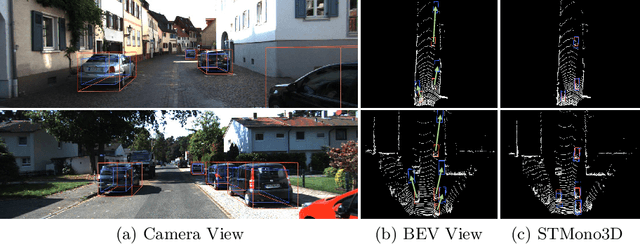

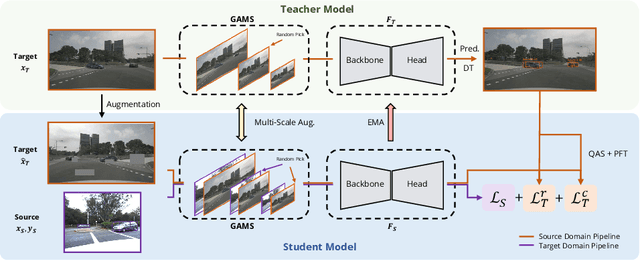
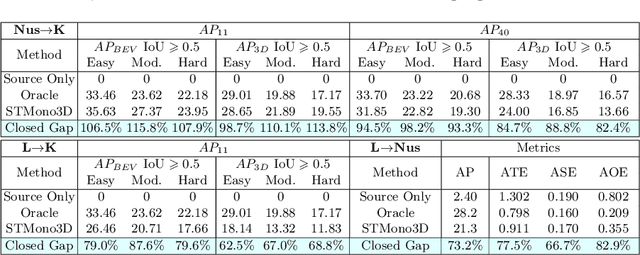
Abstract:Monocular 3D object detection (Mono3D) has achieved unprecedented success with the advent of deep learning techniques and emerging large-scale autonomous driving datasets. However, drastic performance degradation remains an unwell-studied challenge for practical cross-domain deployment as the lack of labels on the target domain. In this paper, we first comprehensively investigate the significant underlying factor of the domain gap in Mono3D, where the critical observation is a depth-shift issue caused by the geometric misalignment of domains. Then, we propose STMono3D, a new self-teaching framework for unsupervised domain adaptation on Mono3D. To mitigate the depth-shift, we introduce the geometry-aligned multi-scale training strategy to disentangle the camera parameters and guarantee the geometry consistency of domains. Based on this, we develop a teacher-student paradigm to generate adaptive pseudo labels on the target domain. Benefiting from the end-to-end framework that provides richer information of the pseudo labels, we propose the quality-aware supervision strategy to take instance-level pseudo confidences into account and improve the effectiveness of the target-domain training process. Moreover, the positive focusing training strategy and dynamic threshold are proposed to handle tremendous FN and FP pseudo samples. STMono3D achieves remarkable performance on all evaluated datasets and even surpasses fully supervised results on the KITTI 3D object detection dataset. To the best of our knowledge, this is the first study to explore effective UDA methods for Mono3D.
Cross-media Scientific Research Achievements Query based on Ranking Learning
Apr 26, 2022Abstract:With the advent of the information age, the scale of data on the Internet is getting larger and larger, and it is full of text, images, videos, and other information. Different from social media data and news data, scientific research achievements information has the characteristics of many proper nouns and strong ambiguity. The traditional single-mode query method based on keywords can no longer meet the needs of scientific researchers and managers of the Ministry of Science and Technology. Scientific research project information and scientific research scholar information contain a large amount of valuable scientific research achievement information. Evaluating the output capability of scientific research projects and scientific research teams can effectively assist managers in decision-making. In view of the above background, this paper expounds on the research status from four aspects: characteristic learning of scientific research results, cross-media research results query, ranking learning of scientific research results, and cross-media scientific research achievement query system.
Mining and searching association relation of scientific papers based on deep learning
Apr 25, 2022Abstract:There is a complex correlation among the data of scientific papers. The phenomenon reveals the data characteristics, laws, and correlations contained in the data of scientific and technological papers in specific fields, which can realize the analysis of scientific and technological big data and help to design applications to serve scientific researchers. Therefore, the research on mining and searching the association relationship of scientific papers based on deep learning has far-reaching practical significance.
Profiling and Evolution of Intellectual Property
Apr 20, 2022Abstract:In recent years, with the rapid growth of Internet data, the number and types of scientific and technological resources are also rapidly expanding. However, the increase in the number and category of information data will also increase the cost of information acquisition. For technology-based enterprises or users, in addition to general papers, patents, etc., policies related to technology or the development of their industries should also belong to a type of scientific and technological resources. The cost and difficulty of acquiring users. Extracting valuable science and technology policy resources from a huge amount of data with mixed contents and providing accurate and fast retrieval will help to break down information barriers and reduce the cost of information acquisition, which has profound social significance and social utility. This article focuses on the difficulties and problems in the field of science and technology policy, and introduces related technologies and developments.
Research on Intellectual Property Resource Profile and Evolution Law
Apr 13, 2022Abstract:In the era of big data, intellectual property-oriented scientific and technological resources show the trend of large data scale, high information density and low value density, which brings severe challenges to the effective use of intellectual property resources, and the demand for mining hidden information in intellectual property is increasing. This makes intellectual property-oriented science and technology resource portraits and analysis of evolution become the current research hotspot. This paper sorts out the construction method of intellectual property resource intellectual portrait and its pre-work property entity extraction and entity completion from the aspects of algorithm classification and general process, and directions for improvement of future methods.
Retrieval of Scientific and Technological Resources for Experts and Scholars
Apr 13, 2022Abstract:Institutions of higher learning, research institutes and other scientific research units have abundant scientific and technological resources of experts and scholars, and these talents with great scientific and technological innovation ability are an important force to promote industrial upgrading. The scientific and technological resources of experts and scholars are mainly composed of basic attributes and scientific research achievements. The basic attributes include information such as research interests, institutions, and educational work experience. However, due to information asymmetry and other reasons, the scientific and technological resources of experts and scholars cannot be connected with the society in a timely manner, and social needs cannot be accurately matched with experts and scholars. Therefore, it is very necessary to build an expert and scholar information database and provide relevant expert and scholar retrieval services. This paper sorts out the related research work in this field from four aspects: text relation extraction, text knowledge representation learning, text vector retrieval and visualization system.
Knowledge Graph and Accurate Portrait Construction of Scientific and Technological Academic Conferences
Apr 11, 2022Abstract:In recent years, with the continuous progress of science and technology, the number of scientific research achievements is increasing day by day, as the exchange platform and medium of scientific research achievements, the scientific and technological academic conferences have become more and more abundant. The convening of scientific and technological academic conferences will bring large number of academic papers, researchers, research institutions and other data, and the massive data brings difficulties for researchers to obtain valuable information. Therefore, it is of great significance to use deep learning technology to mine the core information in the data of scientific and technological academic conferences, and to realize a knowledge graph and accurate portrait system of scientific and technological academic conferences, so that researchers can obtain scientific research information faster.
Research on Cross-media Science and Technology Information Data Retrieval
Apr 11, 2022Abstract:Since the era of big data, the Internet has been flooded with all kinds of information. Browsing information through the Internet has become an integral part of people's daily life. Unlike the news data and social data in the Internet, the cross-media technology information data has different characteristics. This data has become an important basis for researchers and scholars to track the current hot spots and explore the future direction of technology development. As the volume of science and technology information data becomes richer, the traditional science and technology information retrieval system, which only supports unimodal data retrieval and uses outdated data keyword matching model, can no longer meet the daily retrieval needs of science and technology scholars. Therefore, in view of the above research background, it is of profound practical significance to study the cross-media science and technology information data retrieval system based on deep semantic features, which is in line with the development trend of domestic and international technologies.
Accurate Portraits of Scientific Resources and Knowledge Service Components
Apr 11, 2022Abstract:With the advent of the cloud computing era, the cost of creating, capturing and managing information has gradually decreased. The amount of data in the Internet is also showing explosive growth, and more and more scientific and technological resources are uploaded to the network. Different from news and social media data ubiquitous in the Internet, the main body of scientific and technological resources is composed of academic-style resources or entities such as papers, patents, authors, and research institutions. There is a rich relationship network between resources, from which a large amount of cutting-edge scientific and technological information can be mined. There are a large number of management and classification standards for existing scientific and technological resources, but these standards are difficult to completely cover all entities and associations of scientific and technological resources, and cannot accurately extract important information contained in scientific and technological resources. How to construct a complete and accurate representation of scientific and technological resources from structured and unstructured reports and texts in the network, and how to tap the potential value of scientific and technological resources is an urgent problem. The solution is to construct accurate portraits of scientific and technological resources in combination with knowledge graph related technologies.
 Add to Chrome
Add to Chrome Add to Firefox
Add to Firefox Add to Edge
Add to Edge